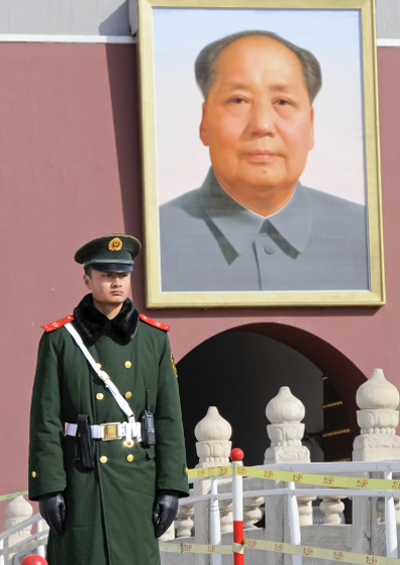Asia: the Challenge to Turn Enmity into Amity
Risks of unresolved territorial conflict threaten peace in Asia.
July 28, 2014

Burgeoning conflicts in the Western Pacific have captured world attention. Ever-more combative conflicts over competing claims between Japan and China over the Senkaku/Diaoyu Islands in the East China Sea have led to confrontation in the air and on the sea.
That China and Japan seem so determined to go toe-to-toe with each other is an ominous trend.
Lurking behind modern leaders are the ghosts of nationalisms past. Resurgent nationalism had terrible consequences in Europe as recently as the breakup of Yugoslavia. Now it is a dangerous challenge to a peaceful global order that all nations must have an interest in if the prosperity of their people is to advance.
Even now, the Europeans are again seeing the rise of ethnic nationalism linked with the use of force by Russia in Ukraine. Russian action in Ukraine recalls the tragic and bloody disintegration of Yugoslavia.
The return of nationalism
World leaders will also look to China and Japan as those countries work to manage their interwoven history. China suffered humiliation at the hands of Imperial Japan. Japanese apologies have been inadequate, and have not gained acceptance from neighboring countries or helped the region move beyond historical grievances.
Resorting to nationalist appeals is a quick, but highly risky device for leaders to try to drum up domestic support. Abroad, nationalism increases fear and animosity in reaction.
In Europe, Russian President Vladimir Putin is aggrieved with the outcome of history and the demise of the Soviet Union – in his mind, the “greatest geopolitical catastrophe of the 20th century.” He now seeks to reverse the effects of history by making an effort to shape current events to recover what he thinks Premier Gorbachev lost in territory and influence.
Putin may be completely misguided, but it is important to understand what motivates him. After all, the sense of affliction and the appeal of ethnic nationalism are not just in his mind, but in the minds of many Russians.
Not forgiven, not forgotten
In China, Japan has failed to achieve acceptance of its acknowledgment of the historic wrongs during the conquest of Nanjing. The controversial visit by Prime Minister Abe to the shrine at Yasukuni provided another significant symbol of a deficit of justice for China.
Japan and China seem caught in a vortex of each country’s cultural vortices. In Japan apology is associated with shame and in China, the wounds of the Second World War sow seeds of new nationalism.
It is apparent that President Xi is promoting a return to the nationalist past in China. For example, he openly recognized Confucius’s contributions to Chinese culture and history. There is understandable interest in traditional Chinese culture, as a part of a political effort to stabilize the country in the aftermath of great economic growth and change.
The Chinese dream
However, promoting nationalism at the cost of rule of law and collaboration with neighbors takes China in the wrong direction.
President Xi has set out to achieve “a Chinese dream” of a “great rejuvenation of the Chinese nation.” The first three priorities, according to him, are:
-
■ restoring Taiwan to China,
-
■ regaining the Diaoyu or Senkaku islands from Japan and
-
■ “taking back sovereignty of the South China Sea,” a maritime territory that is disputed by more than 10 countries.
China is pressing its claims backed by force – which end up undermining its peaceful rise to global power status. The South China Seas confrontation is dangerous.
The middle kingdom extending South
Recent unilateral placement of a deep-sea oil rig by the Chinese National Overseas Oil Company (CNOOC), to assert Chinese claims to the disputed Paracel Islands, has alarmed the United States, Vietnam and others in East Asia.
Although there has been a public groundswell of anti-China sentiment and Vietnam has a compelling desire to defend its maritime territory, as the smaller country, Vietnam has few good options. So Vietnam has to choose a course carefully.
Hanoi knows it needs stable relations with China. Ironically,
given the 1968-1975 war with the United States, it looks to the United States to support stability in the region.
As a result of China’s actions, its neighbors may be forced to seek outside assistance and military cooperation to counterbalance a more aggressive China. That, of course, is the polar opposite of what China ultimately aims for.
Defusing Conflict in the South and East China Seas
To move forward with unilateral energy exploration in the South China Sea, China is using the placement of a deep-sea oil rig to assert its claims to the disputed Paracel Islands. The move has concerned Vietnam and other regional powers, which also claim territorial rights over the waters and islands in that area.
The United States, for its part, is concerned over regional stability, the openness of global commercial sea lanes, as well as legal status issues.
Beijing’s decision will likely prompt Vietnam to deploy its coast guard or naval vessels to assert its own claim to the area and accelerate its efforts to draw in foreign partners for oil exploration and production. But Beijing is calculating that Vietnam will be unwilling and unable to make any serious attempt to stop the Chinese drilling.
Even as Beijing ambitiously claims the entire South China Sea, bounded by the so-called nine-dash line, it has no real presence on any island (besides a few atolls and reefs) in the distant Spratly Island chain.
In addition to China, Malaysia, the Philippines, Vietnam, Brunei and Taiwan have claims in the island chain. China’s navy is not good enough to overcome the logistical challenges such distances present, so its ability to project its dominance throughout the maritime sphere is limited.
Instead, Beijing’s strategy seems to consist of three steps:
-
■ China uses the nine-dash line as a historical justification for its intrusions into disputed waters.
-
■ China enforces its claim in tactically advantageous areas where it has an actual presence, such as the Paracel Islands and the Scarborough Shoal, which it seized from the Philippines in 2012.
-
■ China continues to develop its military and technological capabilities to carefully push its maritime boundaries farther without antagonizing all of its neighbors at once.
Despite growing nationalisms, within and in reaction to China’s rise, which threaten peace, efforts should be made to work cooperatively with China — not to contain it. Japan, China and other nations such as Vietnam and the Philippines should set aside the unresolved issues and turn to joint management of national interests in fishing, energy and resource development.
Codes of conduct in the East and South China Sea are necessary to manage maritime operations. Joint maritime policing, adherence to the Law of the Sea and maintenance of the freedom of the seas for shipping, could also help to avoid political miscalculation and military confrontation.
Most important, the Chinese, Japanese and regional leaders should set aside the use of force to resolve tension, such as those over the Paracel, Senkaku/Diaoyu and other Islands.
From technical cooperation to regional peace
To move forward, it may seem insufficient to focus on seeming technicalities such as developing practical mechanisms for maritime cooperation. And yet, it is precisely such “technical” issues that have the potential for trust and confidence building measures.
That is very much the lesson of Europe in the 1970s. The path embarked on through détente there, via the OSCE and other organizations and processes made true continent-wide reforms and cooperation possible.
Given that hands-on experience, a suitable framework for governments to develop deeper cooperation and collaboration must address the following dimensions:
-
■ Agreeing on the rule of law for resolution of disputes.
This is a primary commitment not to use force to resolve disputes. Adherence to the UN Convention on the Law of the Sea (UNCLOS), implementation of international law and conventions about territories and skies as well as the Code of Conduct and an international convention/ law on cyber and data security are critical for dispute resolution.
-
■ Building international structures for consultation, negotiation and cooperation.
These must have enough power and rights to judge and re-enforce countries respect for laws and conventions. States can build and are building on the East Asian Summit, ASEAN, ASEAN Regional Forums and ASEAN +3 (China, Japan, South Korea) with observers from the United States, India, Australia and New Zealand.
China, Japan and South Korea could create a Trilateral Group to address regional issues in East and North East Asia.There are many issues to be addressed including enhancing transparency in government policies, granting information rights/data protection of people in all countries and managing jointly large marine ecosystems.
-
■ Integrating Asian economies into the global economy.
This process takes shape via the WTO, International Financial Institutions (IFIs) and regional economies as well as rules of global governance. Cooperation among states can also improve rights, safety and life conditions of workers and promote Corporate Social Responsibility.
-
■ Assisting in reconciliation, especially for historical grievances
This is a pre-condition for regional security. Unresolved conflicts are the seeds of nationalism and new confrontation such as those ongoing over the Senkaku, Paracel, Spratley Islands and the Scarborough Reef.
Conclusions
-
■ Efforts should be made to work cooperatively with China — not to contain it, while taking care not to engage in nationalistic antagonisms.
-
■ Japan, China and other nations such as Vietnam and the Philippines should set aside their unresolved issues and turn to joint management of national interests in fishing, energy and resource development.
-
■ Codes of conduct in the East and South China Sea are necessary to manage maritime operations.
-
■ Joint maritime policing, adherence to the Law of the Sea and maintenance of the freedom of the seas for shipping, could also help to forestall political miscalculation and military confrontation.
-
■ Most important, the Chinese, Japanese and regional leaders should take the use of force off the table to resolve tension, such as those over the Paracels, Senkaku/Diaoyu Islands, Scarborough Reef and other disputes.
Japan has a special role to address post WWII reconciliation. It could and should have done much more to give real substance to its apologies, as the Germans have done.
At least since 1970, Germany has taken a comprehensive and credible approach to atoning for its Nazi past. The country has fully acknowledged the horrors it created, not least in its own school curricula.
The longer term challenge — in Europe, involving Russian ethnic nationalism or in Asia with Chinese nationalism — is how to turn enmity into amity.
Then as now, the best way to proceed is to begin with small steps in the resolution of many disputes. And this is where Japan’s Prime Minister must do much more than (implicitly) point the finger at China.
Takeaways
China is pressing its claims backed by force – which end up undermining its peaceful rise to global power status.
Despite growing nationalisms, efforts should be made to work cooperatively with China -- not to contain it.
Asian nationalisms challenge a peaceful global order that all nations must have an interest in.
China's navy is not good enough to overcome the logistical challenges that the South China sea presents.
The longer term challenge for Asian nations is how to turn enmity into amity.
Historical tensions and new breeds of nationalism threaten peace in Asia.
Read previous

The Shifting Landscape for Iran’s Women
July 27, 2014
